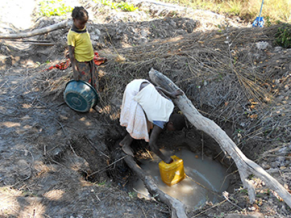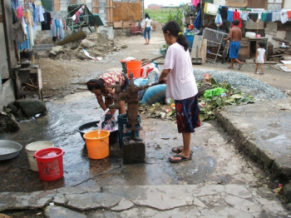Official Development Assistance (ODA)
Safe Water and Sanitation
International Trends Regarding the Sector
 Photo provided JICA
Photo provided JICA
 Photo provided by: Mikio Ishiwatari / JICA
Photo provided by: Mikio Ishiwatari / JICA
- International Trends Regarding the Sector
- Japan's Initiatives
- Statistics
- Links
Overview
Water and sanitation are important issues that affect human lives. Approximately 2.2 billion people around the world have no access to a safely managed supply of drinking water, 4.2 billion people have no access to sanitation facilities such as safely managed toilets, and 3 billion people are living without basic hand washing facilities (source: 2019 UNICEF report ). Furthermore, lack of access to safe water is also hampering economic development.
). Furthermore, lack of access to safe water is also hampering economic development.
For example, in developing countries where water services are not sufficientwidespread, it often falls to women and children to collect water. It sometimes takes them hours to collect water. This deprives the children of opportunities for education and the women of opportunities for social advancement. An unstable water supply also has a negative impact on medical services and agriculture.
From this perspective, Goal 6 of the Sustainable Development Goals (SDGs) adopted at the UN Summit in September 2015 states: "Ensure availability and sustainable management of water and sanitation for all." Water and sanitation measures will also contribute significantly to achieving other Goals besides Goal 6.
In December 2016, the UN General Assembly passed a resolution to make 2018-2028 the "International Decade for Action on Water for Sustainable Development.
to make 2018-2028 the "International Decade for Action on Water for Sustainable Development. " The aim of this International Decade for Action on Water is to renew the international community's resolve to tackle the water problem and raise awareness in it.
" The aim of this International Decade for Action on Water is to renew the international community's resolve to tackle the water problem and raise awareness in it.
[SDG6]
6.1
By 2030, achieve universal and equitable access to safe and affordable drinking water for all.
6.2
By 2030, achieve access to adequate and equitable sanitation and hygiene for all and end open defecation, paying special attention to the needs of women and girls and those in vulnerable situations.
6.3
By 2030, improve water quality by reducing pollution, eliminating dumping and minimizing release of hazardous chemicals and materials, halving the proportion of untreated wastewater and substantially increasing recycling and safe reuse globally.
6.4
By 2030, substantially increase water-use efficiency across all sectors and ensure sustainable withdrawals and supply of freshwater to address water scarcity and substantially reduce the number of people suffering from water scarcity.
6.5
By 2030, implement integrated water resources management at all levels, including through transboundary cooperation as appropriate.
6.6
By 2020, protect and restore water-related ecosystems, including mountains, forests, wetlands, rivers, aquifers and lakes.
6.a
By 2030, expand international cooperation and capacity-building support to developing countries in water- and sanitation-related activities and programmes, including water harvesting, desalination, water efficiency, wastewater treatment, recycling and reuse technologies.
6.b
Support and strengthen the participation of local communities in improving water and sanitation management.
[Current Challenges toward Achieving SDGs Related to Water and Sanitation]
SDG2 (End hunger, achieve food security and improved nutrition and promote sustainable agriculture)
- Child malnutrition and maldevelopment due to a high prevalence of diarrheal illness caused by water-borne diseases
SDG3 (Ensure healthy lives and promote well-being for all at all ages)
- Adverse effects on health due to water-borne diseases such as cholera, dysentery, typhoid, parasitic diseases such as schistosomiasis, fecal-oral infections, and water pollution.
- Adverse effects of the heavy labor of collecting water on the health of women—pregnant women in particular—and children
SDG4 (Ensure inclusive and equitable quality education and promote lifelong learning opportunities for all)
- Adverse effects of children's doing water collection work, such as not being able to go to school, being late, or dropping out of school
- Absence from school due to water-borne diseases
- Lack of adequate sanitation facilities (toilets) in schools and lack of consideration for menstruation leads to a decline in the enrollment rate, particularly among girls
SDG5 (Achieve gender equality and empower all women and girls)
- Water collection work means women and girls have less time for housework, productive activities, and school education, leading to a loss of opportunities
- Privacy is necessary, and women and girls cannot defecate during the day because they are concerned about being seen by others
- The importance of using the toilet increases during the course of menstruation, and it is important to be able to wash hands and dispose of sanitary products appropriately so that they will not be seen by others.
- Sexual harassment may occur in places where there are few people around
SDG Indicators
UNICEF's Main Sectors of Activity (Water and Sanitation)
Major international conferences
- Mr. NAKATANI Shinichi, Parliamentary Secretary for Foreign Affairs, Attends the International Symposium on Water and Culture (February 3, 2020) (in Japanese)
- Mr. SUZUKI Norikazu, Parliamentary Secretary for Foreign Affairs, Attends the "International Symposium on Water and Disasters" (November 29, 2018) (in Japanese)
- The Eighth World Water Forum (March 2018)

